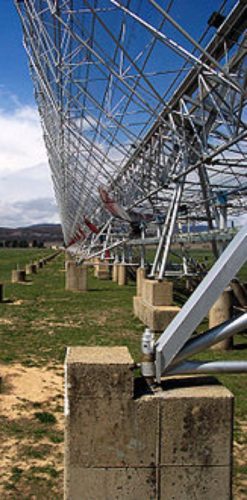In this second in NICHOLE OVERALL’s series on Canberra’s role in observing space, she looks at the Molonglo Observatory Synthesis Telescope at Hoskinstown that, for more than half a century, has been on the lookout for some seriously mysterious cosmological phenomena.
THE moon and Canberra’s contribution to that momentous landing 50 years ago has excited local imaginations, but the chance of alien signals could well come from another space observatory in our backyard.

Ensconced in a lonely valley near tiny Hoskinstown, about 40 kilometres from the capital, is the Molonglo Observatory Synthesis Telescope: MOST. For more than half a century, it’s been on the lookout for some seriously mysterious cosmological phenomena.
According to the observatory’s director, Prof Richard Hunstead, a recent collaboration between Sydney and Swinburne Universities enabled it to continue its cutting-edge work.
“If it hadn’t been for the involvement [of Swinburne], and substantial contribution of hardware and software expertise, the telescope would have been forced to close in 2012,” he says.
After this, its name was also upgraded, to UTMOST.
While many think the radio telescope at Parkes, made famous by the movie “The Dish”, is big at 64 metres diameter, UTMOST is the largest antenna of its kind in the southern hemisphere. And it’s not so much a “dish” as a “big steel cross.”
Its huge cylindrical “arms”, consisting of thousands of independent antennae, extend almost a kilometre each. With five times the “viewing” area of Parkes (more than 18,000 square metres), it can search great swathes of the heavens.
Opened in late 1965 and completed two years before Neil Armstrong made that step on to the lunar surface and into history in 1969, UTMOST continues to be a hotspot for radio astronomy.
In scanning for some of the “strangest objects in the universe”, it produces information critical to the study of things such as black holes. It also allows for the better understanding of theories such as Einstein’s Relativity (I’m no rocket scientist but, at its most basic, the impact of space and time on each other; alternatively, try to grasp what’s going on in the movie “Interstellar”).

Radio waves from outer space were discovered as recently as 1932. Five years later, the first parabolic “dish” antenna – at just nine metres – was built by American Grote Reber.
Prof Hunstead points out that on Reber’s death, some of his ashes were sent to all the major observatories around the world.
“At Molonglo, they’re in a small diecast box in the telescope’s reflector,” he says.
Given the distance of astronomical radio sources – planets, stars, nebulas and galaxies – the equipment had to become larger and more sensitive. This also accounts for why they’re built so far from people: they need to avoid interference from other electronic devices.
In 1954, the innovative Mills Cross Telescope was conceived by CSIR(O) engineer and later professor of astrophysics Bernard Mills. Built near a disused World War II air strip, 40 kilometres west of Sydney, in three short years, it was to become “one of the world’s leading radio astronomy field stations”.
The operational parameters of its first telescope – its 450-metre-long arms providing high resolution and a greater ability to detect weak signals – were described as “remarkable”. Notably, it would conduct a detailed survey revealing numerous “extragalactic” radio emissions – that is, from beyond our Milky Way.
With much clamour for even larger antennae, a “Super Cross” Telescope was constructed outside Canberra, at a cost of almost a million dollars (near on $13 million in today’s terms).
“It was based on the original design by Mills from his pioneering work in the early 1950s,” says Prof Hunstead.
Consisting of north-south and east-west arms, the latter would be modified in 1978 to become MOST. After 40 years, the former has only recently been redeployed.
One of MOST’s major coups was the first-time detection of the moment a supernova erupted: SN1987A, the closest observable exploding star in four centuries.
Supernovas are the end of a massive star’s life (massive = more than eight times heavier than the sun). The end of its life means it’s exhausted its fuel supplies and can’t sustain itself (to really cheer you up, this is what astronomers say will eventually happen to that radiant orb in our sky – though it’ll expand as a “red giant” to likely obliterate us). The remnants, neutron stars, are the densest, directly observable objects known.
Rapidly rotating, highly magnetised versions of these relics – think half a million times the earth’s mass in a sphere the size of a small city – are called pulsars. They emit regular, focused beams of radiation detectable as radio pulses. The first in the southern hemisphere were discovered by the original Molonglo Telescope, the year after it commenced operations.
Between 1967 and 1978, more than half the known pulsars of the time were located by it. Among UTMOST’s primary work is the observation of pulsars and magnetars – another type of neutron star and the most magnetic objects in the universe.
Then there’s its job detecting another of “astronomy’s biggest puzzles” – fast radio bursts (FRBs). These intense, short-lived “cosmic blips” are even further in the nether regions of space. So elusive are they, in the first decade after their 2007 discovery (from archival data collected by the Parkes Observatory), less than 20 were identified. The importance of the still unexplained events could lead to revelations on the composition and mass of the universe.
Heavy stuff, indeed.
In conjunction with other organisations and universities, the ongoing program to search for them has resulted in the 2018 capture of one of the “most energetic FRBs ever detected” (as the energy they produce in a single burst is the equivalent of the output of the sun in a whole day, you get the idea).
A current project setting records for real-time searches for all of this phenomena has also been given another adorable acronym: SMIRF (Survey for Magnetars, Intermittent pulsars, Rotating radio transients and FRBs). It allows for a sweep of the entire southern arc of the Milky Way every 10 days as opposed to once a decade. The volume of information collected means the facility’s recently introduced supercomputers conduct trillions of calculations a second, processing a billion gigabytes of data in a year.
Parkes is one of the telescopes that’s part of SETI – the Scientific Search for Extraterrestrial Intelligence – and Breakthrough Listen, the most comprehensive quest for alien communication using radio wave and light observations. Perhaps though, given the incredible work going on down a backroad of the capital region, just like those first minutes of footage from the moon landing, the next world-stopping moment from outer space will come from Canberra.
More information at anoverallview.wixsite.com/blog.
Who can be trusted?
In a world of spin and confusion, there’s never been a more important time to support independent journalism in Canberra.
If you trust our work online and want to enforce the power of independent voices, I invite you to make a small contribution.
Every dollar of support is invested back into our journalism to help keep citynews.com.au strong and free.
Thank you,
Ian Meikle, editor








Leave a Reply